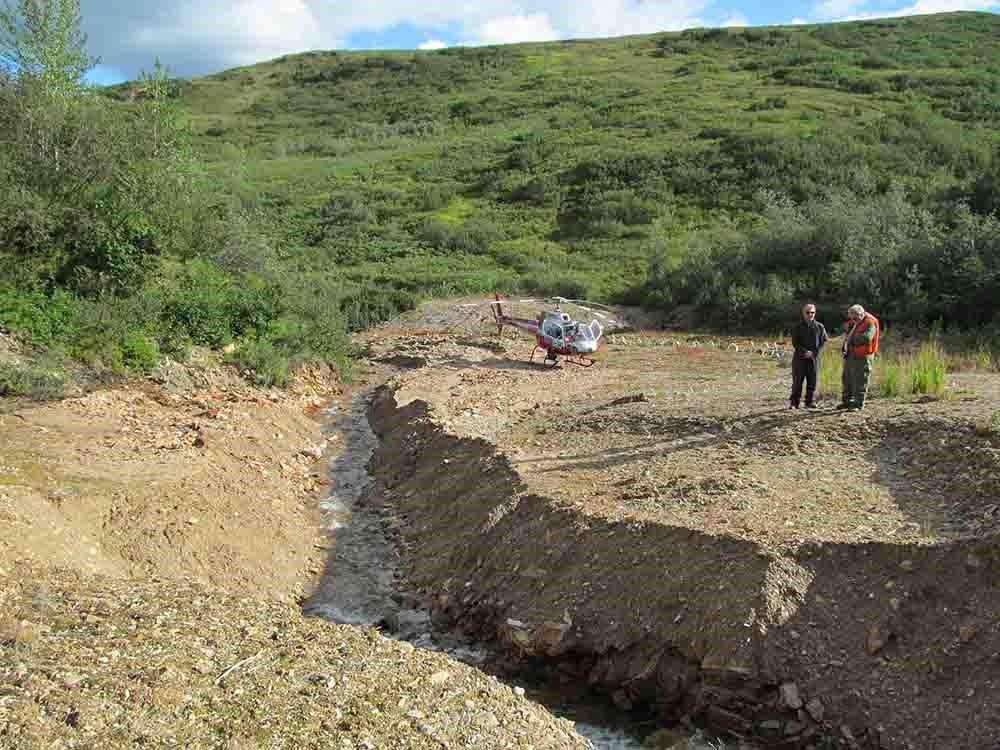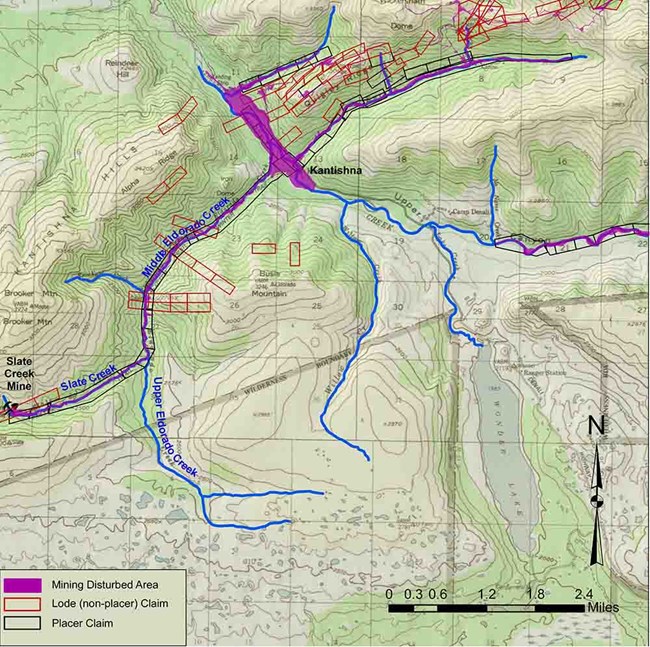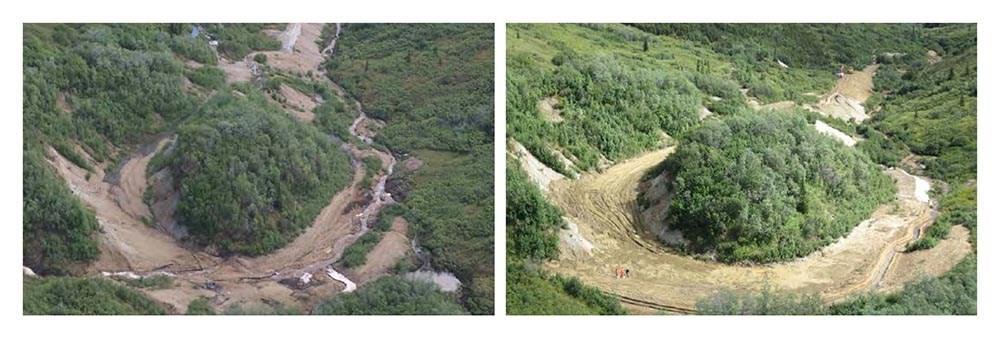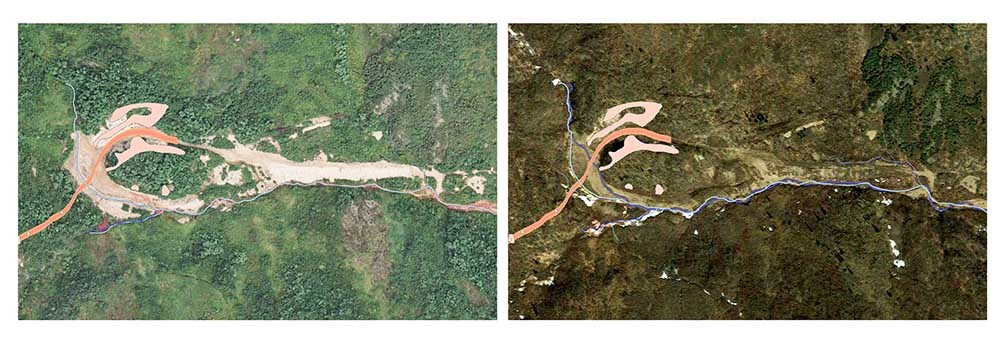Part of a series of articles titled Alaska Park Science - Volume 19, Issue 1 - Below the Surface: Fish and Our Changing Underwater World.
Article
Eldorado: Treasure, Tragedy, and Triumph in the Kantishna Hills
Andrew Kirby, Arizona State University

NPS/PAUL BURGER
Mining has played an important role in Alaska’s national parks, but has left scars and contamination behind that the Park Service is working to clean up. Mining brought awareness to the vast beauty of the state and contributed iconic structures such as the Kennecott Mill in Wrangell-St. Elias National Park and Preserve. The gold rush of 1897-1898, as commemorated in Klondike Gold Rush National Historical Park, brought hundreds of people north into the wilds of Alaska and Canada. As opportunities diminished in Dawson, these pioneers chased gold in Nome and spread out into the interior of Alaska, looking for riches and adventure.
In 1903, James Wickersham and several other men attempted the first ascent of Mount McKinley (Norris 2008). Although they were unsuccessful, Wickersham discovered gold in the stream gravels in the northern Kantishna Hills, in what is now Denali National Park and Preserve, on his way back to Fairbanks (Norris 2008). The following year, gold was found on Friday and Eureka creeks, setting off a stampede by several thousand miners to the Kantishna Hills. Most of the stampeders left the new district by early 1906, because it became obvious that only a few streams carried paying quantities of gold.

From 1901 to 1905, the presence of galena (a lead sulfide), stibnite (an antimony sulfide), and silver prompted a few miners to prospect for lode deposits (Salisbury and Dietz 1984). One of the most significant discoveries of 1905 was a rich deposit of antimony ore in upper Slate Creek (Figure 1; Buzzell 1988). Antimony is considered a strategic metal used for hardening lead and creating semiconductors, diodes, batteries and cable sheathing. More than 325 tons of ore was mined from 1905 to the end of World War II.
People involved in mining operations and related geological and transportation activities helped bring the exceptional scenery and wildlife of the Denali area to the public’s attention. Widely publicized mountaineering expeditions and naturalist Charles Sheldon’s early efforts to protect the area’s wilderness and wildlife led Congress to establish Mount McKinley National Park in 1917 (renamed Denali National Park in 1980).
As antimony mining continued in Slate Creek, deregulation of the price of gold in 1972 brought about a major resurgence of placer mining in the 1970s and early 1980s. Placer mining involving heavy equipment occurred in Moose Creek while smaller operations using mostly hand tools occurred in Eldorado Creek, one of its tributaries.
Expansion of Denali National Park and Preserve in 1980 brought these mines and placer deposits within park boundaries and ended major mining operations in the Kantishna Hills, although placer mining continues. The mining legacy remains in the many miners and their decendants that operate lodges and other visitor services and in the many historic mining structures and features that remain.
The Effects
Not as visible as the old mining-era buildings and equipment, but critical to park resource conservation, are changes mining made to stream channels, aquatic habitats, and water quality. Mining channelized Eldorado Creek, which reduces available habitat for aquatic insects, fish spawning and rearing (Harvey and Lisle 1998, OCAFS 2017). Channelization and removal of large rocks and natural debris from mining reduced habitat complexity, which can reduce aquatic biodiversity (Ward 1998, OCAFS 2017). Land stripped of vegetation for mining erodes more easily and allows fine sediments to wash into streams, that can fill in pores among gravels that are important to developing fish eggs, as well as providing aquatic insect habitat (Waters 1995). Water scientists measure turbidity, how easily light passes through water, as a way to describe the amount of fine sediments suspended in water. Generally, increased turbidity leads to decreased invertebrate density, which are fundamental to stream food webs and can also cause: fish mortality, physical and physiological damage; fish avoidance of turbid areas, and a shift in local aquatic species abundance and composition (Waters 1995, Wenger et al. 2016, OCAFS 2017).
In 1994, the Environmental Protection Agency (EPA) designated Slate Creek as an impaired waterway from its headwaters to its confluence with Eldorado Creek because of excess sediment caused by erosion of the old mine tailings (ADEC 2006). To reduce these effects, reclamation projects in 1997-1998, and again in 2010, included the removal of mining debris and tailings from the floodplain, re-contouring the slopes around the creek, and restructuring the stream channel (Figure 2). These efforts dramatically reduced erosion and testing in 2008-2011 showed that the stream was meeting water quality standards for turbidity (Brabets and Ourso 2013).

USGS/TIM BRABETS (LEFT), NPS (RIGHT)
However, that testing also revealed that metals from the mine site were in the sediments and water downstream. Antimony, arsenic, cadmium, copper, and iron were all present in concentrations many times above levels that have been shown to have a negative effect on aquatic organisms (Brabets and Ourso 2013).
Arctic Grayling Declines
Biologists conducted electrofishing surveys throughout the summer of 1982 to inventory fish abundance and distribution in the Kantishna Hills; the first such surveys was in the Slate/Eldorado Creek basin (Meyer and Kavanagh 1983). While the section of Eldorado Creek downstream of the confluence with Slate Creek had low Arctic grayling (Thymallus arcticus) abundance, averaging 4.6 fish per kilometer, researchers found Eldorado Creek above the confluence (Figure 1) had the highest Arctic grayling densities of all streams sampled in the Kantishna Hills, averaging 33.3 fish per kilometer (Meyer and Kavanagh 1983:24), suggesting that while the quality of grayling habitat below Slate was poor, fish were still able to move through it to reach Upper Eldorado.
Mining had been dormant for several years on Slate Creek when the 1982 fish survey was conducted, but placer mining was active at the mouth of Eldorado Creek. Despite this activity, Arctic grayling were distributed throughout Eldorado Creek with an observed average of 7.5 fish per kilometer (Meyer and Kavanagh 1983: 24, 73). The following year, the Slate Creek Mine became active again. A fish survey found fewer grayling in lower Eldorado than the previous year, especially starting 300 feet downstream of the confluence with Slate Creek (Deschu and Kavanagh 1986). No further surveys were done until 2017.
During 2017 and 2018, the park conducted fish surveys in Eldorado Creek. At this time, suction dredging was active in Eldorado Creek. Four targeted visual surveys were performed in 2017, and one electrofishing and three targeted visual surveys were conducted in 2019. No fish were detected in Eldorado upstream of Slate Creek in either year.
Eldorado Creek above the Slate confluence still has excellent physical habitat, good water quality, and a thriving aquatic macroinvertebrate community (A. Kirby, written communication 2019). During 2017-2018, there were no long-term physical barriers to migration from Moose Creek to the summer foraging habitat upstream of Slate Creek; streamflow and water temperatures are similar to those recorded in the 1980s. Until 2016, no mining had occurred within the watershed for over 30 years. However, habitat below the confluence with Slate Creek exhibits significantly disturbed channel. Water quality degradation from Slate Creek and naturally mineralized springs along Eldorado Creek continues to contribute heavy metals (e.g., arsenic, antimony, and iron) to the creek.
The 2017-2018 study indicates a number of factors that have influenced grayling presence, abundance, and movement in the Eldorado watershed, primarily destruction of habitat and poor water quality. Both may be improved through restoration efforts.
2014 Flooding Leads to a Reimagining of Restoration
In the spring of 2014, a massive rainstorm hit the Kantishna area, washing out roads and changing the course of many streams and rivers in the area. At the Slate Creek mine site, a channel constructed to keep water away from the main ore deposit completely failed after showing signs of deterioration three years before. The stream returned to its pre-reclamation position in the valley and many of the erosion-control structures were washed away (Figure 3).

Stream restoration and reclamation has evolved quickly in the past decade. We now look not only at restoring the overall shape and pattern of a stream, but also what is needed to restore natural function. Stream function refers to the physical, chemical, functions and biological processes that occur in these ecosystems. In 2017, a major effort was made by the park to revisit the site and to gather data needed to develop a strategy to improve physical and biological stream function.
What Does the Future Hold?
In 2017, the National Park Service, in cooperation with the Bureau of Land Management and Stream Mechanics, PLLC Inc., surveyed unmined streams in the Slate Creek/Eldorado Creek watershed. Stream width, depth, area, bed material sizes, and slope were measured and used to determine how much water they could transport. To determine what a naturally functioning stream in the area should look like, the team evaluated channel stability and aquatic habitat by measuring physical characteristics such as pool and riffle spacing.
These measurements were repeated on sections of Slate Creek that have been impacted by mining or that were modified to provide access to the mine site. By comparing the measurements of the disturbed areas versus the natural areas, we can quantify the amount of change that has taken place in the stream. We can also use this information to create a restoration design for returning the stream to a more natural, stable state.
Analysis of the information led to the development of alternative stream restoration designs that the park is evaluating for cost and feasibility. The hope is to create a robust approach for restoring natural function to Slate Creek and improve habitat to facilitate the recovery of native aquatic species.
This project has provided a model for evaluating all of the major mined sites in the park over the next several years. Understanding the potential for recovery in these streams will help the National Park Service to prioritize those areas where intervention is needed over those areas that are recovering naturally, where disturbance might do more harm than good. This approach to stream restoration will serve to improve stream habitat in the park where the legacy of mining has left its mark.
References
Alaska Department of Environmental Conservation (ADEC). 2006.
Alaska’s final 2006 integrated water quality monitoring and assessment report: Alaska Department of Environmental Conservation. Available at: http://www.dec.state.ak.us/water/wqsar/waterbody/docs/2006finalIntegratedReport.pdf (accessed December 5, 2012)
Brabets, T. P. and R. T. Ourso. 2013.
Water quality of streams draining abandoned and reclaimed mined lands in the Kantishna Hills area, Denali National Park and Preserve, Alaska, 2008-11: US Geological Survey Scientific Investigations Report 2013-5048, 72 p.
Buzzell, R. 1988.
Drainage histories of the Kantishna Mining District, Eldorado and Slate Creeks. Unpublished report. National Park Service, Anchorage, Alaska. p.1, 3-4, 6, 9.
Deschu, N. A. and R. C. Kavanagh. 1985.
Water quality and the effects of mining activities in the Kantishna Hills, Denali National Park, 1983. Research/Resources Management Report AR-5. National Park Service, Anchorage, Alaska.
Harvey, B. C. and T. E. Lisle. 1998.
Effects of suction dredging on streams: A review and an evaluation strategy. Fisheries 23: 8-17.
Meyer, S. C. and R. C. Kavanagh. 1983.
Fish resources and the effects of mining activities in the Kantishna Hills, Denali National Park, 1982. National Park Service, Anchorage, Alaska.
Norris, F. 2008.
Crown jewel of the north: An administrative history of Denali National Park and Preserve, Volume 2. National Park Service, Alaska Regional Office, Anchorage, Alaska. p. 325.
Oregon Chapter of the American Fisheries Society (OCAFS). 2017.
Suction dredge mining impacts on Oregon fishes, aquatic habitats, and Human Health. Available at: http://orafs.org/wp-content/uploads/2012/07/ORAFS-Suction-Dredge-Final-Package-020217-1.pdf (accessed April 17, 2020)
Salisbury and Dietz, Inc. 1984.
Mineral resource studies in the Kantishna Hills and Dunkle Mine Areas, Denali National Park and Preserve, Alaska. Prepared for Bureau of Mines, Control No. S0134031, 3 volumes. p. 78, 80, 138.
Ward, J. V. 1998.
Riverine landscapes: Biodiversity patterns, disturbance regimes, and aquatic conservation. Biological Conservation 8(3):269-278.
Waters, T. F. 1995.
Sediment in streams. American Fisheries Society Monograph 7. Bethesda, MD.
Wenger, A. S. and 14 co-authors. 2017.
A critical analysis of the direct effects of dredging on fish. Fish and Fisheries 18:967-985.
Last updated: May 29, 2020
